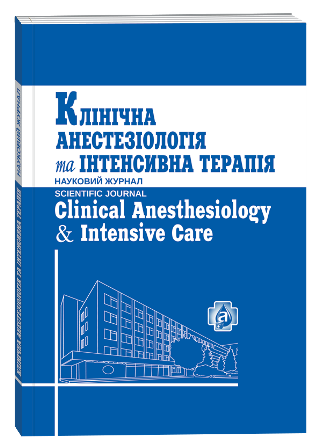HEMOSTASIOLOGICAL MARKERS PREDICTING THE SEVERITY OF ACUTE PANCREATITIS
DOI:
https://doi.org/10.31379/2411.2616.14.2.6Keywords:
acute pancreatitis, hemostasis disorders, thromboelastogram.Abstract
The aim of the study was to identify a prognostically significant hemostasis marker for determining the severity of acute pancreatitis. Materials and methods. The analysis of results of treatment of 482 patients with acute pancreatitis was carried out. The average score of the severity of patients on the APACHE II scale was 9 points, according to the Ranson system, 5 points. In the treatment of acute pancreatitis, minimally invasive technologies were used as the main and final method. Hemostasiological parameters were analyzed: activated partial thromboplastin time, prothrombin time, the number of platelets and fibrinogen, the level of antithrombin and soluble fibrin-monomer complexes, aggregation activity of thrombocytes. Thromboelastography was used as an integral method for assessing the functional state of the hemostatic system. The prognostic significance of the identified patterns was evaluated on the basis of ROC analysis. Results. According to the results of multivariate regression analysis, among the qualitative parameters, the most prognostically significant factor in the development of severe pancreatitis is the MA thromboelastogram score (b = 0.652, p <0.033). In the formation of a normal clot according to the TEG data, at the early stage of the pathological process, severe pancreatitis developed in 7.7% of patients, with a pathologically dense clot recorded in 22.2% of patients, and in the presence of a pathologically loose clot in 65.5% of patients. An early predictor of the development of severe pancreatitis was the presence of a pathologically loose clot from the data of thromboelastogram. The ROC analysis showed good predictive value of the revealed regularity (AUROC = 0.808, 95% confidence interval – 0.686- 0.898, P= < 0,0001). Сonclusion. Hemostasiological marker for the prediction of severe degree of acute pancreatitis – the presence of a patient with a pathologically loose clot from entering a thromboelastogram.
References
Roberts SE, Akbari A, Thorne K, Atkinson M, Evans PA. The incidence of acute pancreatitis: Impact of social deprivation, alcohol consumption, seasonal and demographic factors. Aliment. Pharmacol. Ther. 2013;38:539–548.
Banks P.A., Bollen T.L., Dervenis C., Gooszen H.G., Johnson C.D., Sarr M.G., Tsiotos G.G.,Vege S.S. Acute Pancreatitis Classification Working Group. Classification of acute pancreatitis 2012: revision of the Atlanta classification and definitions by international consensus. Gut. 2013; 62 (1): 102–111.
Орлов Ю.П., Говорова Н.В., Глущенко А.В., Колядко А.В., Ночная Ю.А. Острый панкреатит глазами анестезиолога-реаниматолога: комментарии к российским рекомендациям по лечению острого панкреатита. Вестник интенсивной терапии. 2016; 4:34-40.
Синьков С.В., Ройтман Е.В., Заболотских И.Б. Критерии сепсис-индуцированной коагулопатии: что нового? Вестник интенсивной терапии им. А.И. Салтанова. 2019; 3:52-57.
Yang N, Hao J, Zhang D. Antithrombin III and D-dimer levels as indicators of disease severity in patients with hyperlipidaemic or biliary acute pancreatitis. Journal of International Medical Research 2017;45(1):147–158.
Yang N, Zhang D-L, Hao J-Y. Coagulopathy and the prognostic potential of D-dimer in hyperlipidemia- induced acute pancreatitis. Hepatobiliary Pancreat. Dis. Int. 2015; 4:633–641.
Dumnicka P, Maduzia D, Ceranowicz P, Olszanecki R, Drożdż R, Kuśnierz-Cabala B. The Interplay between Inflammation, Coagulation and Endothelial Injury in the Early Phase of Acute Pancreatitis: Clinical Implications. Int J Mol Sci. 2017;18(2):E354.
Gris J-C, Bouvier S, Cochery-Nouvellon E, Faillie J-L, Lissalde-Lavigne G, Lefrant J-Y. Fibrinrelated markers in patients with septic shock: Individual comparison of D-dimers and fibrin monomers impacts on prognosis. Thromb Haemost 2011;106:1228–1230.
Radenkovic DV, Bajec DD, Karamarkovic AR. Discussion on applicability of disseminated intravascular coagulation parameters in the assessment of the severity of acute pancreatitis. Pancreas. 2006;33(1):106-107.
Chen P, Zhang Y, Qiao M, Yuan Y. Activated protein C, an anticoagulant polypeptide, ameliorates severe acute pancreatitis via regulation of mitogen-activated protein kinases. J. Gastroenterol. 2007;42:887–896.
Saif MW. DIC secondary to acute pancreatitis. Clin. Lab. Haematol. 2005;27:278–282.
Буланов А.Ю., Яцков К.В., Буланова Е.Л., Доброва Н.В. Тромбоэластография: клиническая значимость теста на функциональный фибриноген. Вестник интенсивной терапии. 2017; 1:5-11.
Спиридонова Е.А., Щукин В.В., Жарков П.А. и соавт. Периоперационный гемостазиологический мониторинг: цель и лабораторное сопровождение. Вестник интенсивной терапии. 2016; 1:37-46.







